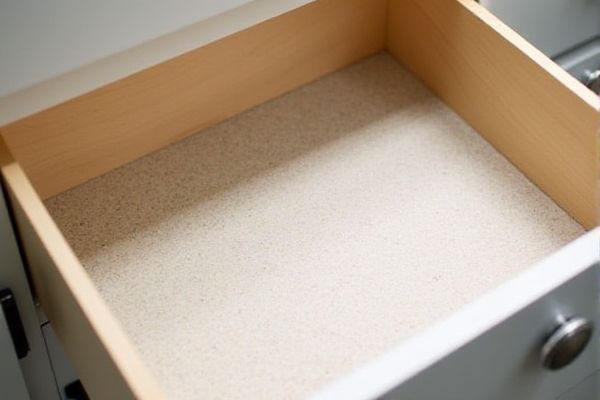
Non-slip drawer liners provide enhanced grip and prevent items from shifting, offering better organization compared to regular liners that mainly serve as protection. Explore this article to discover which drawer liner suits Your needs for a tidy and secure drawer setup.
Table of Comparison
| Feature | Non-slip Drawer Liners | Regular Drawer Liners |
|---|---|---|
| Material | Rubber, PVC, or textured plastic | Plastic, paper, or fabric |
| Grip | High friction surface prevents slipping | Minimal to no grip, items can slide |
| Durability | Long-lasting, resistant to wear | Less durable, prone to tearing |
| Cleaning | Easy to wipe clean and reusable | Often single-use, hard to clean |
| Use Case | Ideal for kitchens, toolboxes, and areas with movement | Best for decorative purposes and light storage |
| Price | Moderate, higher due to material quality | Low, budget-friendly |
Introduction to Drawer Liners
Non-slip drawer liners provide enhanced grip and stability, preventing items from shifting or sliding inside drawers compared to regular drawer liners. Made from materials like rubber or textured foam, non-slip liners improve organization and protect drawer surfaces from damage. Regular liners, often made of smooth plastic or paper, mainly serve decorative or protective roles but lack the friction needed to keep contents securely in place.
What Are Non-Slip Drawer Liners?
Non-slip drawer liners are specially designed mats made from materials like rubber, silicone, or textured foam that prevent items from sliding around inside drawers. Unlike regular drawer liners that primarily protect surfaces and may easily shift, non-slip liners securely hold utensils, tools, or cosmetics in place, reducing clutter and damage. Using these liners enhances organization and ensures your belongings stay tidy and accessible every time you open a drawer.
What Are Regular Drawer Liners?
Regular drawer liners are thin sheets made from materials like paper, vinyl, or foam designed to protect drawer surfaces from scratches, spills, and stains. They often come in smooth textures that can shift or slide when drawers are opened or closed, providing basic protection without added grip. Unlike non-slip drawer liners that use textured or rubberized surfaces to keep items securely in place, regular liners prioritize surface coverage over stability.
Key Differences Between Non-Slip and Regular Liners
Non-slip drawer liners feature textured surfaces or adhesive backing designed to keep items securely in place, preventing shifting and sliding during drawer use. Regular drawer liners typically provide basic protection against scratches and stains but lack grip-enhancing properties, often resulting in items moving around. The key difference lies in the material composition and surface texture, where non-slip liners use rubberized or silicone elements to maximize stability, whereas regular liners prioritize cushioning or decorative appeal without slip resistance.
Benefits of Non-Slip Drawer Liners
Non-slip drawer liners provide superior grip to keep items securely in place, preventing shifting and potential damage during drawer use. These liners often feature textured surfaces made from rubber or silicone materials, enhancing stability compared to regular smooth liners. By using non-slip drawer liners, your drawers remain organized and your belongings protected, reducing noise and prolonging the lifespan of stored items.
Advantages of Regular Drawer Liners
Regular drawer liners offer a versatile and affordable solution for protecting drawer surfaces from scratches, spills, and stains. These liners come in various materials such as paper, plastic, and fabric, making it easy to find an option that matches your style and needs. You can easily replace or clean regular liners, ensuring drawers stay fresh and organized over time.
Drawbacks of Non-Slip Drawer Liners
Non-slip drawer liners often have a textured surface that can make cleaning more difficult compared to regular smooth liners, trapping dirt and debris more easily. These liners may also wear out faster due to constant friction, leading to peeling or curling at the edges over time. If not properly sized or installed, non-slip liners can shift, defeating their purpose and potentially damaging your drawers.
Potential Disadvantages of Regular Drawer Liners
Regular drawer liners often lack the textured surface necessary to prevent items from sliding, increasing the risk of disorganized or damaged contents. Their smooth material can shift or bunch up inside drawers, reducing their effectiveness and requiring frequent adjustment. You may find these liners less reliable for keeping utensils or fragile items securely in place compared to non-slip alternatives.
Choosing the Right Drawer Liner for Your Needs
Non-slip drawer liners provide a secure grip that prevents items from shifting, making them ideal for kitchens and tool drawers where stability is essential. Regular drawer liners offer basic protection against scratches and spills but lack the textured surface needed to hold items in place during opening and closing. Choosing the right drawer liner depends on your specific needs for grip, cushioning, and ease of cleaning to ensure your drawers stay organized and functional.
Conclusion: Which Drawer Liner Is Better?
Non-slip drawer liners provide enhanced grip to prevent items from shifting, making them ideal for kitchens and toolboxes where stability is crucial. Regular drawer liners offer basic protection against scratches and spills but lack the textured surface needed to keep objects firmly in place. For optimal organization and safety, non-slip drawer liners outperform regular options in maintaining neatness and reducing the risk of breakage.
 homyna.com
homyna.com